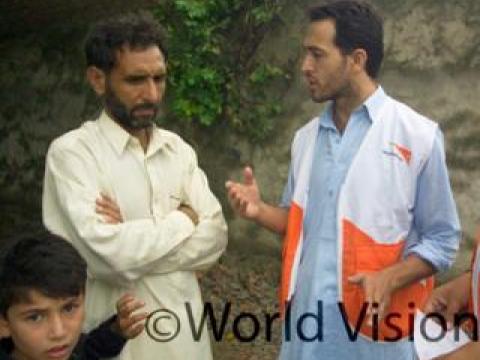Twice unlucky – displaced by conflict now homeless

He could only watch helplessly as his whole life\'s work slid into the river. All he could make out with unbelieving eyes were huge trees helplessly rolling and being tossed around by mad waves at thunderous speed.
Khan had worked hard in Karachi as a baker making bread in the hot oven around which hotels run their business. He still works as a baker in Lower Dir. The house represented all his life\'s savings.
“Flood is a lingering disaster. The pain not only stays but comes back with vengeful frequency especially if you are poor”, declares the hapless father of 10 children, five sons and five daughters.
But Khan is no stranger to calamity.
He and his family were also among the 2.5 million Internally Displaced Persons (IDPs) that were rendered homeless when Pakistan\'s armed forces carried out an operation to clear the districts of Swat, Buner and Dir from Taliban extremists in May 2009. He and his family spent a very painful six months in Jalozai camp for IDPS before returning back to his home and what he thought would be a peaceful and secure life.
Standing on a 105 feet square plot of land on the edge of the river, with five rooms, a large courtyard and the boundary wall next to the three acres of agricultural land made the baker a proud pathan (Pastun) land owner. He lived with his younger brother Kazim Zaman who was married only a few months ago. His house was situated right on the brink of the river bank but the rooms were located farther away- to one side on the right.
The floods began with torrential rains on July 28 and the Bajaur River quickly overflowed its banks. He was alarmed when the outer boundary wall fell into the river after waters eroded the land below it. To Khan’s horror, he noticed the river had started to erode the land under his house with a ferocity beyond human imagination.
He moved his children and all his belongings to his elder brother’s house next door. The families huddled together having put the children to sleep. Having gone through traumatic experiences of internal displacement, the children have learnt to live in the midst of a crisis. They fell asleep or just remained unnoticed by the elders.
“I sat watching helplessly praying to God to spare the roof over my children\'s heads”, he tells of the night of August 2, 2010 when the river took away his house. There was more rain and an even more ferocious flood than the first wave.
The water soon thundered through the five-room walled brick house and then the whole house fell into the river. “There was nothing left to indicate that it ever existed. It vanished as if it never was,” mumbles the dazed owner trying to cope with the stress of how to rebuild his lost life.
"It would have been better if I had died in the floods as the compulsion to rebuild a new life is much more painful," says 37-year-old Shah Izzat Khan.
According to Pakistan\'s National Disaster Management Authority, there are more than 875, 562 flood-damaged houses across Pakistan- affecting more than 5.2 million people.
“The scale of the response needed by all humanitarian actors is almost incomprehensible,” said Anita Cole, Programme Development and Quality Director for World Vision Pakistan. “World Vision is moving quickly to mobilise the human and financial resources needed to scale up programmes so we can respond as soon as the immediate danger posed by the flood passes”.
ENDS